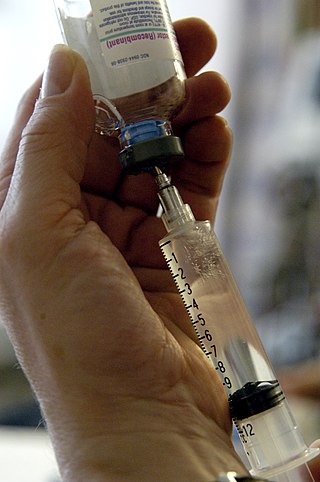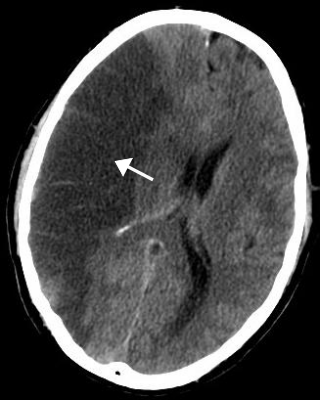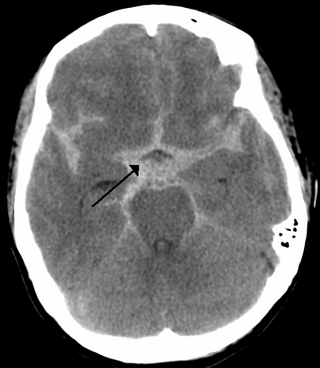
An arteriovenous malformation (AVM) is an abnormal connection between arteries and veins, bypassing the capillary system. Usually congenital, this vascular anomaly is widely known because of its occurrence in the central nervous system, but can appear anywhere in the body. The symptoms of AVMs can range from none at all to intense pain or bleeding, and they can lead to other serious medical problems.

Neurology is the branch of medicine dealing with the diagnosis and treatment of all categories of conditions and disease involving the nervous system, which comprises the brain, the spinal cord and the peripheral nerves. Neurological practice relies heavily on the field of neuroscience, the scientific study of the nervous system.

Thrombosis is the formation of a blood clot inside a blood vessel, obstructing the flow of blood through the circulatory system. When a blood vessel is injured, the body uses platelets (thrombocytes) and fibrin to form a blood clot to prevent blood loss. Even when a blood vessel is not injured, blood clots may form in the body under certain conditions. A clot, or a piece of the clot, that breaks free and begins to travel around the body is known as an embolus.

Cerebrovascular disease includes a variety of medical conditions that affect the blood vessels of the brain and the cerebral circulation. Arteries supplying oxygen and nutrients to the brain are often damaged or deformed in these disorders. The most common presentation of cerebrovascular disease is an ischemic stroke or mini-stroke and sometimes a hemorrhagic stroke. Hypertension is the most important contributing risk factor for stroke and cerebrovascular diseases as it can change the structure of blood vessels and result in atherosclerosis. Atherosclerosis narrows blood vessels in the brain, resulting in decreased cerebral perfusion. Other risk factors that contribute to stroke include smoking and diabetes. Narrowed cerebral arteries can lead to ischemic stroke, but continually elevated blood pressure can also cause tearing of vessels, leading to a hemorrhagic stroke.

Cerebral edema is excess accumulation of fluid (edema) in the intracellular or extracellular spaces of the brain. This typically causes impaired nerve function, increased pressure within the skull, and can eventually lead to direct compression of brain tissue and blood vessels. Symptoms vary based on the location and extent of edema and generally include headaches, nausea, vomiting, seizures, drowsiness, visual disturbances, dizziness, and in severe cases, death.

An air embolism, also known as a gas embolism, is a blood vessel blockage caused by one or more bubbles of air or other gas in the circulatory system. Air can be introduced into the circulation during surgical procedures, lung over-expansion injury, decompression, and a few other causes. In flora, air embolisms may also occur in the xylem of vascular plants, especially when suffering from water stress.

Interventional radiology (IR) is a medical specialty that performs various minimally-invasive procedures using medical imaging guidance, such as x-ray fluoroscopy, computed tomography, magnetic resonance imaging, or ultrasound. IR performs both diagnostic and therapeutic procedures through very small incisions or body orifices. Diagnostic IR procedures are those intended to help make a diagnosis or guide further medical treatment, and include image-guided biopsy of a tumor or injection of an imaging contrast agent into a hollow structure, such as a blood vessel or a duct. By contrast, therapeutic IR procedures provide direct treatment—they include catheter-based medicine delivery, medical device placement, and angioplasty of narrowed structures.

Ischemia or ischaemia is a restriction in blood supply to any tissue, muscle group, or organ of the body, causing a shortage of oxygen that is needed for cellular metabolism. Ischemia is generally caused by problems with blood vessels, with resultant damage to or dysfunction of tissue i.e. hypoxia and microvascular dysfunction. It also implies local hypoxia in a part of a body resulting from constriction. Ischemia causes not only insufficiency of oxygen, but also reduced availability of nutrients and inadequate removal of metabolic wastes. Ischemia can be partial or total blockage. The inadequate delivery of oxygenated blood to the organs must be resolved either by treating the cause of the inadequate delivery or reducing the oxygen demand of the system that needs it. For example, patients with myocardial ischemia have a decreased blood flow to the heart and are prescribed with medications that reduce chronotrophy and ionotrophy to meet the new level of blood delivery supplied by the stenosed vasculature so that it is adequate.

Stroke is a medical condition in which poor blood flow to the brain causes cell death. There are two main types of stroke: ischemic, due to lack of blood flow, and hemorrhagic, due to bleeding. Both cause parts of the brain to stop functioning properly.

The Terri Schiavo case was a series of court and legislative actions in the United States from 1998 to 2005, regarding the care of Theresa Marie Schiavo, a woman in an irreversible persistent vegetative state. Schiavo's husband and legal guardian argued that Schiavo would not have wanted prolonged artificial life support without the prospect of recovery, and in 1998, he elected to remove her feeding tube. Schiavo's parents disputed her husband's assertions and challenged Schiavo's medical diagnosis, arguing in favor of continuing artificial nutrition and hydration. The highly publicized and prolonged series of legal challenges presented by her parents, which ultimately involved state and federal politicians up to the level of President George W. Bush, caused a seven-year delay before Schiavo's feeding tube was ultimately removed.

Subarachnoid hemorrhage (SAH) is bleeding into the subarachnoid space—the area between the arachnoid membrane and the pia mater surrounding the brain. Symptoms may include a severe headache of rapid onset, vomiting, decreased level of consciousness, fever, weakness, numbness, and sometimes seizures. Neck stiffness or neck pain are also relatively common. In about a quarter of people a small bleed with resolving symptoms occurs within a month of a larger bleed.
The legislative, executive, and judicial branches, of both the United States federal government and the State of Florida, were involved in the case of Terri Schiavo. In November 1998 Michael Schiavo, husband of Terri Schiavo, first sought permission to remove his wife's feeding tube. Schiavo had suffered brain damage in February 1990, and in February 2000 had been ruled by a Florida circuit court to be in a persistent vegetative state. Her feeding tube was removed first on April 26, 2001, but was reinserted two days later on an appeal by her parents, Bob and Mary Schindler.

Cerebral hypoxia is a form of hypoxia, specifically involving the brain; when the brain is completely deprived of oxygen, it is called cerebral anoxia. There are four categories of cerebral hypoxia; they are, in order of increasing severity: diffuse cerebral hypoxia (DCH), focal cerebral ischemia, cerebral infarction, and global cerebral ischemia. Prolonged hypoxia induces neuronal cell death via apoptosis, resulting in a hypoxic brain injury.

Computed tomography angiography is a computed tomography technique used for angiography—the visualization of arteries and veins—throughout the human body. Using contrast injected into the blood vessels, images are created to look for blockages, aneurysms, dissections, and stenosis. CTA can be used to visualize the vessels of the heart, the aorta and other large blood vessels, the lungs, the kidneys, the head and neck, and the arms and legs. CTA can also be used to localise arterial or venous bleed of the gastrointestinal system.
Steven T. DeKosky is the Aerts-Cosper Professor of Alzheimer's Research at the University of Florida (UF) College of Medicine, deputy director of UF’s Evelyn F. and William L. McKnight Brain Institute (MBI) and associate director of the 1Florida Alzheimer’s Disease Research Center.
Ronald Eugene Cranford was a neurologist and expert on comas and unconsciousness. He is best known for his work with families on public cases involving persons in a persistent vegetative state. He and three other doctors were responsible for introducing the "do not resuscitate" order. He worked with the families of such notable cases as the Karen Ann Quinlan case, Paul Brophy, Nancy Cruzan case and Terri Schiavo case.
George Euripedes Tragos is a Criminal Defense and Personal Injury attorney located in Clearwater, Florida. He has participated in a number of cases that have received national attention; these include the Terri Schiavo case, a civil suit against Nick Hogan, and the Stephen Coffeen case in which he successfully argued what has been dubbed the "Red Bull defense". He is senior partner at the personal injury law firm Tragos, Sartes & Tragos, PA.

Jeffrey A. Brent is a medical toxicologist who is a distinguished clinical professor of medicine and emergency medicine at the University of Colorado, School of Medicine. In addition, he is a professor at the Department of Environmental and Occupational Health at the Colorado School of Public Health. He is also the past president of the American Academy of Clinical Toxicology, was editor in chief of the journal Toxicological Reviews, and was a member of the board of directors of the American College of Medical Toxicology. Previously, most of Brent's research focused on the use of fomepizole as a treatment for both methanol and ethylene glycol poisoning, and he led a trial of this drug which resulted in the FDA approving it in December 1997. Currently, Brent serves as Director of the Toxicology Investigators Consortium, an NIH and FDA supported multi center research and surveillance group. Brent is also a senior editor of "Critical Care Toxicology: Diagnosis and Management of the Critically Poisoned Patient," originally published in 2005, and now in its second edition, which was published in 2017.

Jahi McMath was a thirteen-year-old girl who was declared brain dead in California following surgery in 2013. This led to a bioethical debate engendered by her family's rejection of the medicolegal findings of death in the case, and their efforts to maintain her body using mechanical ventilation and other measures. Her parents considered these measures to constitute life support, while her doctors considered this to be futile treatment of a deceased person. In October 2014, the McMath family attorney made the unprecedented request that Jahi McMath's brain death declaration be overturned. The attorney later withdrew this request, saying he wanted time for the court-appointed medical expert and his own medical experts to confer. In March 2015, McMath's family filed a malpractice lawsuit against Children's Hospital Oakland and against the surgeon who performed McMath's surgery, indicating they were prepared to argue as part of the lawsuit that McMath is not dead, but profoundly disabled. The family lawyer stated that a preliminary second death certificate was issued on June 22, 2018, listing extensive bleeding relating to liver failure as the cause of death.














